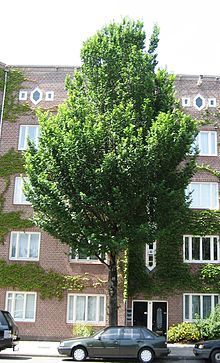Ulmus 'Clusius'
| Ulmus 'Clusius' | |
|---|---|
 Ulmus 'Clusius', Netherlands. | |
| Genus | Ulmus |
| Hybrid parentage | ('Exoniensis' × U. wallichiana) × 'Bea Schwarz' selfed |
| Cultivar | 'Clusius' |
| Origin | Wageningen, The Netherlands |
Ulmus 'Clusius' is a Dutch hybrid elm cultivar raised at the Dorschkamp Research Institute for Forestry & Landscape Planning, Wageningen, and released to commerce in 1983. 'Clusius' was derived from a crossing of the same Dutch clones that produced the fastigiate 'Lobel' released in 1973: '202' ('Exoniensis' × U. wallichiana) and '336' ('Bea Schwarz' selfed).
Description

The tree has a broader crown than its siblings', whilst the generally obovate leaves, < 11 cm long by 7 cm wide, are less acuminate at the apex.[1][2] Like 'Lobel', the tree flushes markedly later than most other elms, and is rarely in full leaf before mid-May.
Pests and diseases
Whilst the resistance of 'Clusius' to Dutch elm disease proved marginally greater than that of its Dutch predecessors, rated 4 out of 5,[3] it has been eclipsed by later developments such as Lutèce. Consequently, sales in the Netherlands declined from over 8,000 in 1979 to 600 in 2004.[4]
Cultivation
While 'Clusius' remains for sale in Europe, its planting where the disease remains prevalent cannot be recommended.[5] 'Clusius' featured in New Zealand government trials during the 1990s at the Hortresearch station, Palmerston North, but is not known to have been introduced to North America.
Etymology
The cultivar is named for Carolus Clusius, a Dutch naturalist of the Renaissance.
Accessions
- Europe
- Arboretum de La Petite Loiterie [1], Monthodon, France. No details available
- Grange Farm Arboretum, Sutton St James, Spalding, Lincs., UK. Acc. no. 817.
- Sir Harold Hillier Gardens, Ampfield, Romsey, Hampshire, UK. Acc. no: 2019.0441
- Wijdemeren City Council, Netherlands. Elm Collection. planted mainly in Kortenhoef since 2006.
Nurseries
- Noordplant [2], Glimmen, Netherlands.
References
- ^ Heybroek, Hans M. (1983). Burdekin, D.A. (ed.). "Resistant elms for Europe" (PDF). Forestry Commission Bulletin (Research on Dutch Elm Disease in Europe) (60). London: HMSO: 108–113.
- ^ Heybroek, H.M. (1993). "The Dutch Elm Breeding Program". In Sticklen, Mariam B.; Sherald, James L. (eds.). Dutch Elm Disease Research. New York, USA: Springer-Verlag. pp. 16–25. ISBN 978-1-4615-6874-2. Retrieved 26 October 2017.
- ^ Heybroek, H. M., Goudzwaard, L, Kaljee, H. (2009). Iep of olm, karakterboom van de Lage Landen (:Elm, a tree with character of the Low Countries). KNNV, Uitgeverij. ISBN 978-90-5011-281-9
- ^ Hiemstra, J.A.; et al. (2007). Belang en toekomst van de iep in Nederland [Importance and future of the elm in the Netherlands]. Wageningen, Netherlands: Praktijkonderzoek Plant & Omgeving B.V. Retrieved 26 October 2017.
- ^ Burdekin, D.A.; Rushforth, K.D. (November 1996). "Elms resistant to Dutch elm disease" (PDF). Arboriculture Research Note. 2/96. Revised by J.F. Webber. Alice Holt Lodge, Farnham: Arboricultural Advisory & Information Service: 1–9. ISSN 1362-5128. Retrieved 26 October 2017.
- v
- t
- e
- U. alata (Winged elm)
- U. americana (American elm)
- U. americana var. floridana (Florida elm)
- U. bergmanniana (Bergmann's elm)
- U. bergmanniana var. bergmanniana
- U. bergmanniana var. lasiophylla
- U. castaneifolia (Chestnut-leafed or multinerved elm)
- U. changii (Hangzhou elm)
- U. changii var. changii
- U. changii var. kunmingensis (Kunming elm)
- U. chenmoui (Chenmou or Langya Mountain elm)
- U. chumlia
- U. crassifolia (Cedar or Texas cedar elm)
- U. davidiana (David or Father David elm)
- U. davidiana var. davidiana
- U. davidiana var. japonica (Japanese elm)
- U. elongata (Long raceme elm)
- U. gaussenii (Anhui or hairy elm)
- U. glabra (Wych or scots elm)
- U. glaucescens (Gansu elm)
- U. glaucescens var. glaucescens
- U. glaucescens var. lasiocarpa (hairy-fruited glaucescent elm)
- U. harbinensis (Harbin elm)
- U. ismaelis
- U. laciniata (Manchurian cut-leaf or lobed elm)
- U. laciniata var. nikkoensis (Nikko elm)
- U. laevis (European white elm)
- U. laevis var. celtidea
- U. laevis var. parvifolia
- U. laevis var. simplicidens
- U. lamellosa (Hebei elm)
- U. lanceifolia (Vietnam elm)
- U. macrocarpa (Large-fruited elm)
- U. macrocarpa var. glabra
- U. macrocarpa var. macrocarpa
- U. mexicana (Mexican elm)
- U. microcarpa (Tibetan elm)
- U. minor (Field elm)
- U. minor subsp. minor
- U. minor var. italica
- U. parvifolia (Chinese or lacebark elm)
- U. parvifolia var. coreana (Korean elm)
- U. prunifolia (Cherry-leafed elm)
- U. pseudopropinqua (Harbin spring elm)
- U. pumila (Siberian elm)
- U. rubra (Slippery elm)
- U. serotina (September elm)
- U. szechuanica (Szechuan (Sichuan) or red-fruited elm)
- U. thomasii (Rock or cork elm)
- U. uyematsui (Alishan elm)
- U. villosa (Cherry-bark or marn elm)
- U. wallichiana (Himalayan or kashmir elm)
- U. wallichiana subsp. wallichiana
- U. wallichiana subsp. xanthoderma
- U. wallichiana var. tomentosa
- U. boissieri
- U. minor subsp. canescens (Grey, grey-leafed or hoary elm)
- U. elliptica
- U. davidiana var. japonica × U. minor
- U. × arbuscula
- U. × arkansana
- U. × brandisiana
- U. × diversifolia
- U. × hollandica (Dutch elm)
- U. × hollandica var. insularum
- U. × intermedia
- U. × mesocarpa
- aff. Plotii
- Acutifolia
- Alata
- Alksuth
- Argenteo-Marginata
- Aspera
- Atropurpurea
- Australis
- Berardii
- Betulaefolia Nigrescens
- Crispa
- Crispa Aurea
- Crispa Pendula
- Densa
- Exoniensis
- Fastigiata Glabra
- Folia Aurea
- Folia Rubra
- Folia Variegata Pendula
- Gallica
- Glabra
- Globosa
- Hamburg
- Hertfordensis Angustifolia
- Hertfordensis Latifolia
- Hillieri
- Jalaica
- Jacqueline Hillier
- Kansas Hybrid
- Klemmer Blanc
- Koopmannii
- Lombartsii
- Louis van Houtte
- Marmorata
- Monstrosa
- Myrtifolia
- Myrtifolia Purpurea
- Nemoralis
- Nigrescens
- Planeroides
- Planifolia
- Purpurea
- Pyramidalis Bertini
- Ramulosa
- Rotundifolia
- Rubra
- Rufa
- Rugosa
- Scampstoniensis
- Sericea
- Tiliaefolia
- Tortuosa
- Turkestanica
- Variegata Nova
- Virens
- U. okanaganensis











